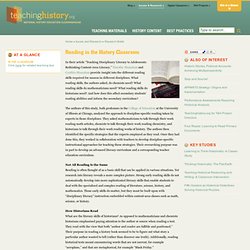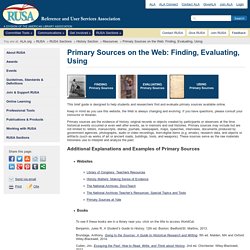

Kakadu National Park. During the Creation Time, the creation ancestors travelled across the landscape.

Some creation ancestors are still active today. “All things in the landscape were left by the creation ancestors. They taught Aboriginal people how to live with the land. From then on Aboriginal people became keepers of their country.” — Warradjan Aboriginal Cultural Centre Namarrkon Rock art at Burrungkuy (Nourlangie) depicting Namarrkon. This rock art depicts Namarrkon (pronounced narm-arr-gon). The band running from Namarrkon’s left ankle to his hands and head and down to his right ankle represents the lightning he creates. Namarrkon’s story in this area is part of a larger story. On Namarrkon’s last journey, he approached the Arnhem Land escarpment from the east and looked over the sheer wall. Document Analysis Worksheets. Español Document analysis is the first step in working with primary sources.
Teach your students to think through primary source documents for contextual understanding and to extract information to make informed judgments. Use these worksheets — for photos, written documents, artifacts, posters, maps, cartoons, videos, and sound recordings — to teach your students the process of document analysis. Follow this progression: Primary Source Analysis Tool. Finding Primary Sources. Citing Primary Sources. Citing primary sources correctly is an important part of studying primary sources, for a number of reasons.

It is important--and ethically necessary--to provide full credit to the creators and publishers of documents, and to allow future scholars to find the source quickly and correctly. Citing a primary source is also crucial to critical thinking and analysis because it requires that the student think carefully about where the source came from, who made it, and in what context the student first discovered it.
Today, most students have access to primary sources through electronic means. The examples below serve as a guide to the most common formats and types available on the Library of Congress Web site. Citation Examples for Library of Congress Digitized Primary Sources Great variation exists among accepted styles, and different disciplines rely on different style guidelines. Why Use Primary Sources? Primary sources provide a window into the past—unfiltered access to the record of artistic, social, scientific and political thought and achievement during the specific period under study, produced by people who lived during that period.

Bringing young people into close contact with these unique, often profoundly personal, documents and objects can give them a very real sense of what it was like to be alive during a long-past era. 1. Engage students Primary sources help students relate in a personal way to events of the past and promote a deeper understanding of history as a series of human events.Because primary sources are snippets of history, they encourage students to seek additional evidence through research.First-person accounts of events helps make them more real, fostering active reading and response. 2. Primary Source Analysis Tool. Primary Source Analysis Tool. Reading in the History Classroom. In their article “Teaching Disciplinary Literacy to Adolescents: Rethinking Content-Area Literacy,” Timothy Shanahan and Cynthia Shanahan provide insight into the different reading skills required for success in different disciplines.

What reading skills, the authors asked, do chemists need? What reading skills do mathematicians need? What reading skills do historians need? And how does this affect secondary students’ reading abilities and inform the secondary curriculum? The authors of this study, both professors in the College of Education at the University of Illinois at Chicago, analyzed the approach to discipline-specific reading taken by experts in those disciplines. Not All Reading Is the Same Reading is often thought of as a basic skill that can be applied in various situations.
How Historians Read What are the literacy skills of historians? A History Events Chart One strategy was a “history events chart.” In the Classroom Sample Application For more information Bibliography. Evernote for Teachers. How to use Primary Sources. Finding Primary Sources. Finding Historical Primary Sources What are Primary Sources?
Primary sources were either created during the time period being studied or were created at a later date by a participant in the events being studied (as in the case of memoirs). They reflect the individual viewpoint of a participant or observer. Primary sources enable the researcher to get as close as possible to what actually happened during an historical event or time period What are Secondary Sources? A secondary source is a work that interprets or analyzes an historical event or phenomenon. Using Primary Sources on the Web. This brief guide is designed to help students and researchers find and evaluate primary sources available online.

Keep in mind as you use this website, the Web is always changing and evolving. If you have questions, please consult your instructor or librarian. Primary sources are the evidence of history, original records or objects created by participants or observers at the time historical events occurred or even well after events, as in memoirs and oral histories. Primary sources may include but are not limited to: letters, manuscripts, diaries, journals, newspapers, maps, speeches, interviews, documents produced by government agencies, photographs, audio or video recordings, born-digital items (e.g. emails), research data, and objects or artifacts (such as works of art or ancient roads, buildings, tools, and weapons).